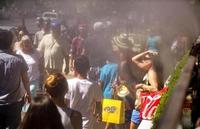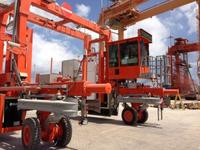-
Heat waves to become more frequent, severe

Climate change is set to trigger more frequent and severe heat waves in the next thirty years regardless of the amount of carbon dioxide (CO2) we emit into the atmosphere, a new study has shown. In the first half of the twenty-first century, these projections will occur regardless of the amount of CO2 emitted into the atmosphere. After then, the rise in frequency of extreme heat waves becomes dependent on the emission scenario adopted.
-
-
Breakthrough fuel cell technology: the future of electricity generation
We currently rely upon an increasingly vulnerable electrical grid to provide the energy we need. The best way to decrease that vulnerability is through distributed energy, that is, by making our own energy on-site. A breakthrough fuel cell technology promises to provide always-on electricity to businesses, homes, and eventually automobiles, at about one-tenth the cost and one-tenth the size of current commercial fuel cell systems. The technology allows people to generate their own electricity with a system nearly impervious to hurricanes, thunderstorms, cyberattacks, derechos, and similar dangers, while simultaneously helping the environment.
-
-
Budding scientists visit leading U.K. science facilities
A group of budding science students visited some of the U.K.’s leading science facilities last week as part of their prize for projects in a national competition. The students all took part in the finals of the U.K. National Science & Engineering Competition at this year’s Big Bang Fair in London. They were judged to be the winner and runners-up for the Institute of Physics (IOP) prize, awarded for the best physics project.
-
-
Detecting radioactive material smuggled in containers

Nearly 90 percent of imported and exported goods travel the globe in shipping containers. Roughly 500 million containers travel the sea each year. A Sandia National Laboratories team completed acceptance testing on an enormous mobile scanner — the Mobile Radiation Detection and Identification System (MRDIS) — which makes smuggling radiological materials in containers more difficult.
-
-
New camouflage makeup shields soldiers, firefighters from heat of bomb blasts, fire
Camouflage face makeup for warfare is undergoing one of the most fundamental changes in thousands of years, as scientists today described a new face paint that both hides soldiers from the enemy and shields their faces from the searing heat of bomb blasts. Firefighters also could benefit from the new heat-resistant makeup.
-
-
Climate change was proximate, not primary, cause of 2012 Great Plains drought: study

From May to July 2012, the Great Plains region of the western United States faced a powerful and unpredicted drought. Following seven months of normal rainfall, the drought was one of the largest deviations from seasonal precipitation rates seen in the region since observations began in 1895. Researches find that the drought fell within the bounds of natural atmospheric variability. The strength of the drought, they suggest, was a consequence of the multiple complex nonlinear systems that make up the climate system and did not critically depend on the existence of a strong external forcing.
-
-
Top 6 hottest new weapons
Competition spurs innovation and there is nothing more competitive than countries battling in the trenches of war. With billions upon billions in defense budget to spend, research into developing the best and most efficient weapons is on the forefront of investment.
-
-
Site of proposed Los Angeles skyscrapers may contain active seismic fault
Officials at New York-based Millennium Partners have agreed to dig a trench on a site proposed for two towers, thirty-nine and thirty-five stories tall, flanking the iconic Capitol Records building in Los Angeles. Opponents of the project say there is an active seismic fault under the planned location for the two towers, and the developer says the trench will allow geologists to see whether or not it would be safe to build the towers on the proposed site. Critics say that a panel of neutral experts, led by state officials, should do the geological investigation.
-
-
Better approach toward projecting, planning for rising sea levels on a warmer Earth
More useful projections of sea level are possible despite substantial uncertainty about the future behavior of massive ice sheets, according to Princeton University researchers. The researchers present a probabilistic assessment of the Antarctic contribution to twenty-first century sea-level change. Their methodology folds observed changes and models of different complexity into unified projections that can be updated with new information. This approach provides a consistent means to integrate the potential contribution of both continental ice sheets — Greenland and Antarctica — into sea-level rise projections.
-
-
Bolstering national grid resilience as extreme weather events intensify
Between 2003 and 2012, an estimated 679 widespread power outages in the United States occurred due to severe weather. A recent Congressional Research Service study estimates the inflation-adjusted cost of weather-related outages at $25 to $70 billion annually. A new White House report says that grid resilience is increasingly important as climate change increases the frequency and intensity of severe weather.
-
-
Teams compete in challenging robotic helicopter competition

A U Michigan student team took part in an autonomous aerial vehicle competition. Their task: build a 3-pound flying machine that can, under its own control, take off, fly through a window into a model building, avoid security lasers, navigate the halls, recognize signs, enter the correct room, find a flash drive in a box on a desk, pick it up, leave a decoy, exit, and land in under ten minutes. Beyond military uses, autonomous vehicle they built could one day be used to survey collapsed buildings or inspect hard-to-get-to parts of bridges and other infrastructure. An offshoot group from a previous U-M team is working to commercialize the U-M technology through a startup called SkySpecs, which inspects windmills.
-
-
Groundwater in Vietnam threatened by a new source of arsenic
In Southern Asia, an estimated 100 million people have been exposed to risks from groundwater contaminated with naturally occurring arsenic. The tainted water, used for drinking, agriculture, and industry, has resulted in a variety of serious health risks, including cancer. “Dig deep” to avoid naturally occurring arsenic contamination has been promoted as an answer to obtaining safe water in South Asia, but arsenic has been found in numerous deep wells drilled in the Mekong Delta region of southern Vietnam.
-
-
Small modular reactors (SMEs) a “poor bet” to revive U.S. nuclear renaissance: report
A shift to small modular reactors (SMRs) is unlikely to breathe new life into the troubled U.S. nuclear power industry, since SMRs will likely require tens of billions of dollars in federal subsidies or government purchase orders, create new reliability vulnerabilities, as well as concerns in relation to both safety and proliferation, according a report issued last week.
-
-
A 34-story wooden skyscraper to be built in Stockholm
A Swedish architectural form is building a 34-story wood skyscraper in downtown Stockholm. Solid wood will be the predominant material in the building’s pillars and beams, while inside the apartments, walls, ceilings, fittings and window frames will be also constructed of wood.The firm says that wood is not only cheaper than either steel or concrete, but is also more fire resistant than both. This is due to 15 percent of wood mass being water, which will evaporate before the wood actually burns. In addition, logs get charred which protects the core.
-
-
Aging grid limiting exploitation of wind power potential
Energy firms and utility companies continue to invest in wind power, as evident in the increasing number of wind turbines on the prairies of the Midwest, but the aging infrastructure of the nation’s power grid is limiting the potential of this clean energy source.
-